Strategic Management Report: British Airways, Virgin Atlantic Analysis
VerifiedAdded on 2022/12/26
|10
|2933
|42
Report
AI Summary
This report provides a comprehensive analysis of strategic management principles, focusing on the application of these principles to the airline industry, specifically British Airways and Virgin Atlantic. The report begins with an introduction to strategic management, defining strategy and explaining the roles of strategic planning. It then delves into Wheelen's model of strategic management and the importance of external business environment audits, utilizing tools such as PESTLE analysis, Porter's 5 Forces, and SWOT analysis to evaluate the competitive landscapes of both airlines. The report further explores change management, examining the reasons for organizational changes and introducing McKinsey's 7-S model. It also discusses Mintzberg's emergent approach and Kurt Lewin's prescriptive approach to strategic change. Finally, the report highlights the significance of Key Performance Indicators (KPIs) in strategic planning and change management processes, providing specific examples of KPIs for British Airways and Virgin Atlantic. The report concludes with a summary of the key findings and a list of references.
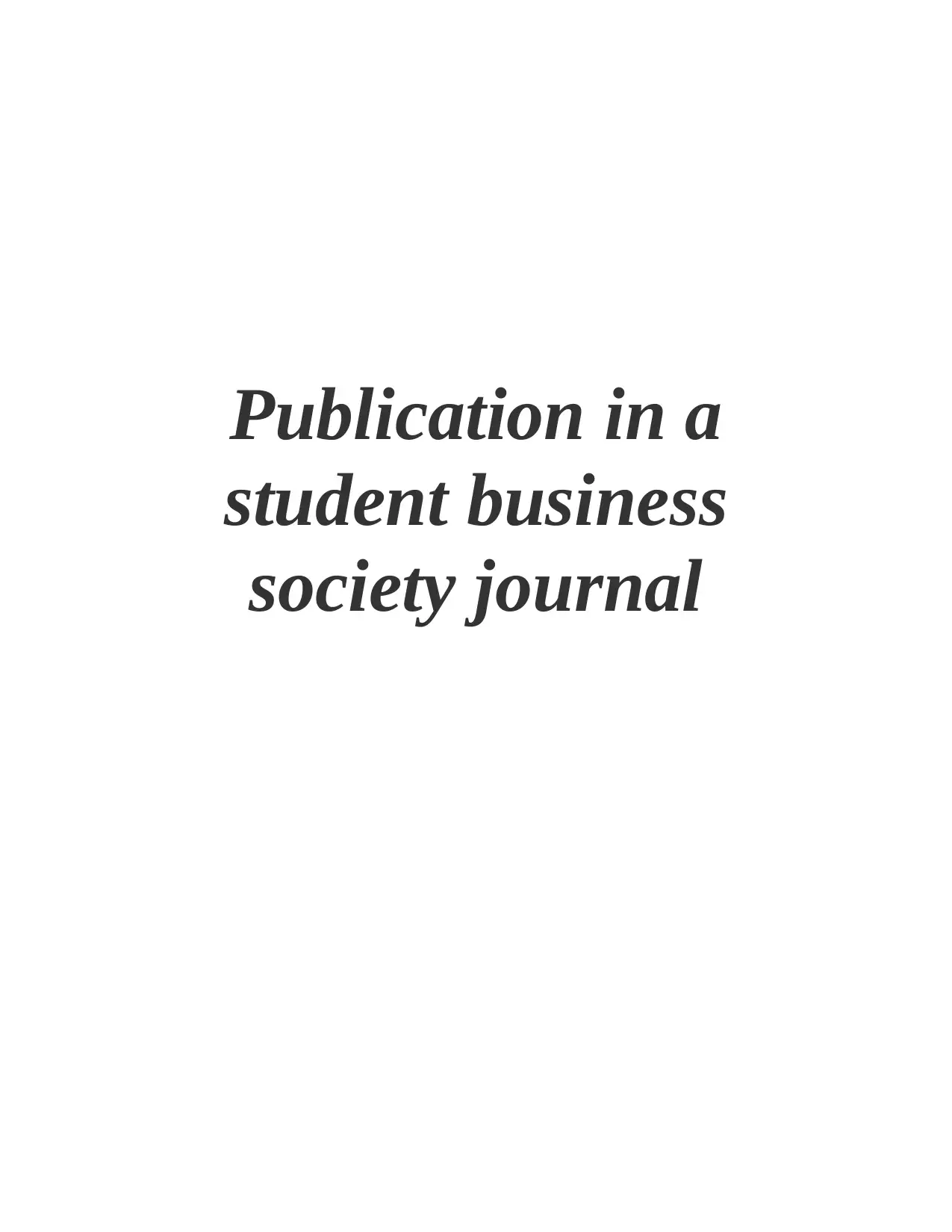
Publication in a
student business
society journal
student business
society journal
Paraphrase This Document
Need a fresh take? Get an instant paraphrase of this document with our AI Paraphraser
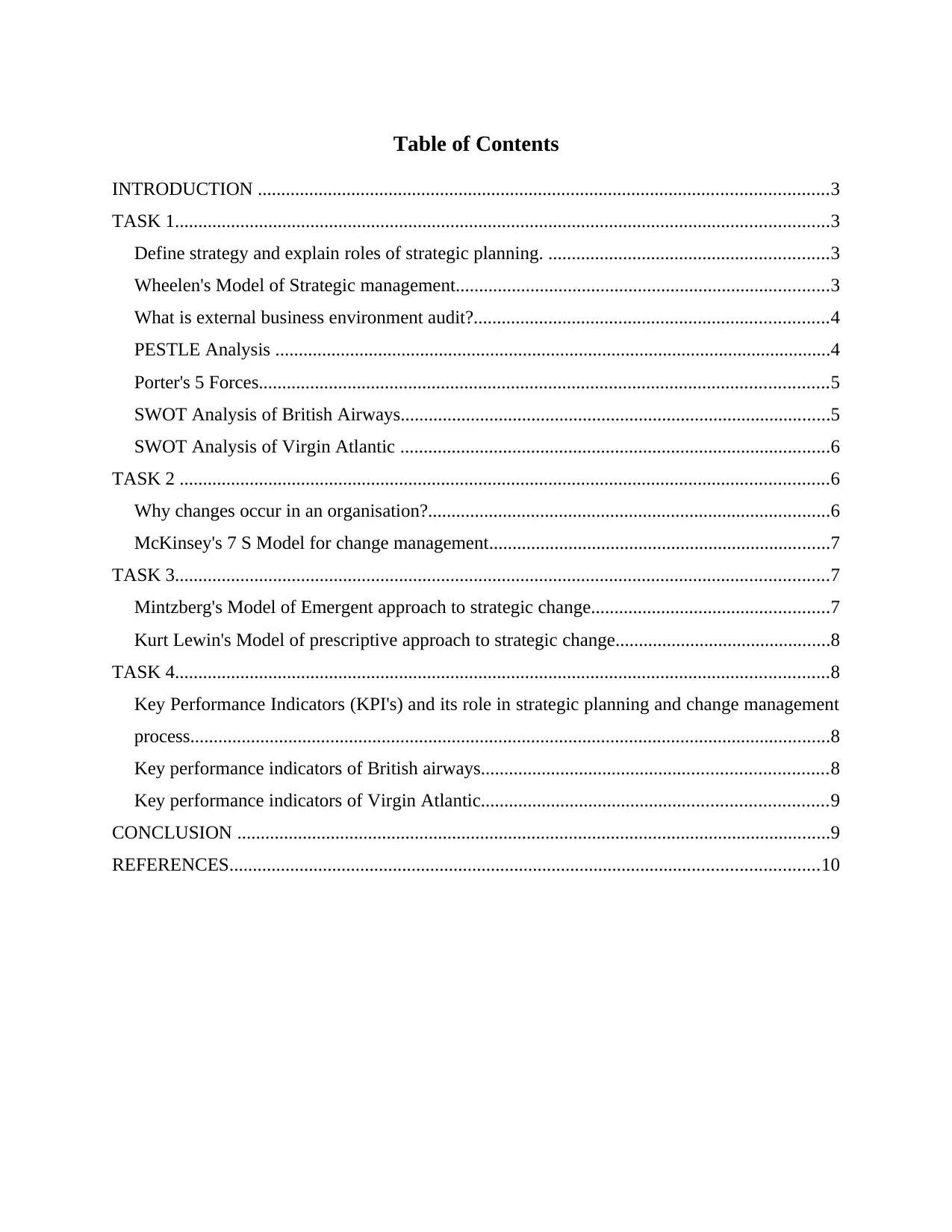
Table of Contents
INTRODUCTION ..........................................................................................................................3
TASK 1............................................................................................................................................3
Define strategy and explain roles of strategic planning. ............................................................3
Wheelen's Model of Strategic management................................................................................3
What is external business environment audit?............................................................................4
PESTLE Analysis .......................................................................................................................4
Porter's 5 Forces..........................................................................................................................5
SWOT Analysis of British Airways............................................................................................5
SWOT Analysis of Virgin Atlantic ............................................................................................6
TASK 2 ...........................................................................................................................................6
Why changes occur in an organisation?......................................................................................6
McKinsey's 7 S Model for change management.........................................................................7
TASK 3............................................................................................................................................7
Mintzberg's Model of Emergent approach to strategic change...................................................7
Kurt Lewin's Model of prescriptive approach to strategic change..............................................8
TASK 4............................................................................................................................................8
Key Performance Indicators (KPI's) and its role in strategic planning and change management
process.........................................................................................................................................8
Key performance indicators of British airways..........................................................................8
Key performance indicators of Virgin Atlantic..........................................................................9
CONCLUSION ...............................................................................................................................9
REFERENCES..............................................................................................................................10
INTRODUCTION ..........................................................................................................................3
TASK 1............................................................................................................................................3
Define strategy and explain roles of strategic planning. ............................................................3
Wheelen's Model of Strategic management................................................................................3
What is external business environment audit?............................................................................4
PESTLE Analysis .......................................................................................................................4
Porter's 5 Forces..........................................................................................................................5
SWOT Analysis of British Airways............................................................................................5
SWOT Analysis of Virgin Atlantic ............................................................................................6
TASK 2 ...........................................................................................................................................6
Why changes occur in an organisation?......................................................................................6
McKinsey's 7 S Model for change management.........................................................................7
TASK 3............................................................................................................................................7
Mintzberg's Model of Emergent approach to strategic change...................................................7
Kurt Lewin's Model of prescriptive approach to strategic change..............................................8
TASK 4............................................................................................................................................8
Key Performance Indicators (KPI's) and its role in strategic planning and change management
process.........................................................................................................................................8
Key performance indicators of British airways..........................................................................8
Key performance indicators of Virgin Atlantic..........................................................................9
CONCLUSION ...............................................................................................................................9
REFERENCES..............................................................................................................................10
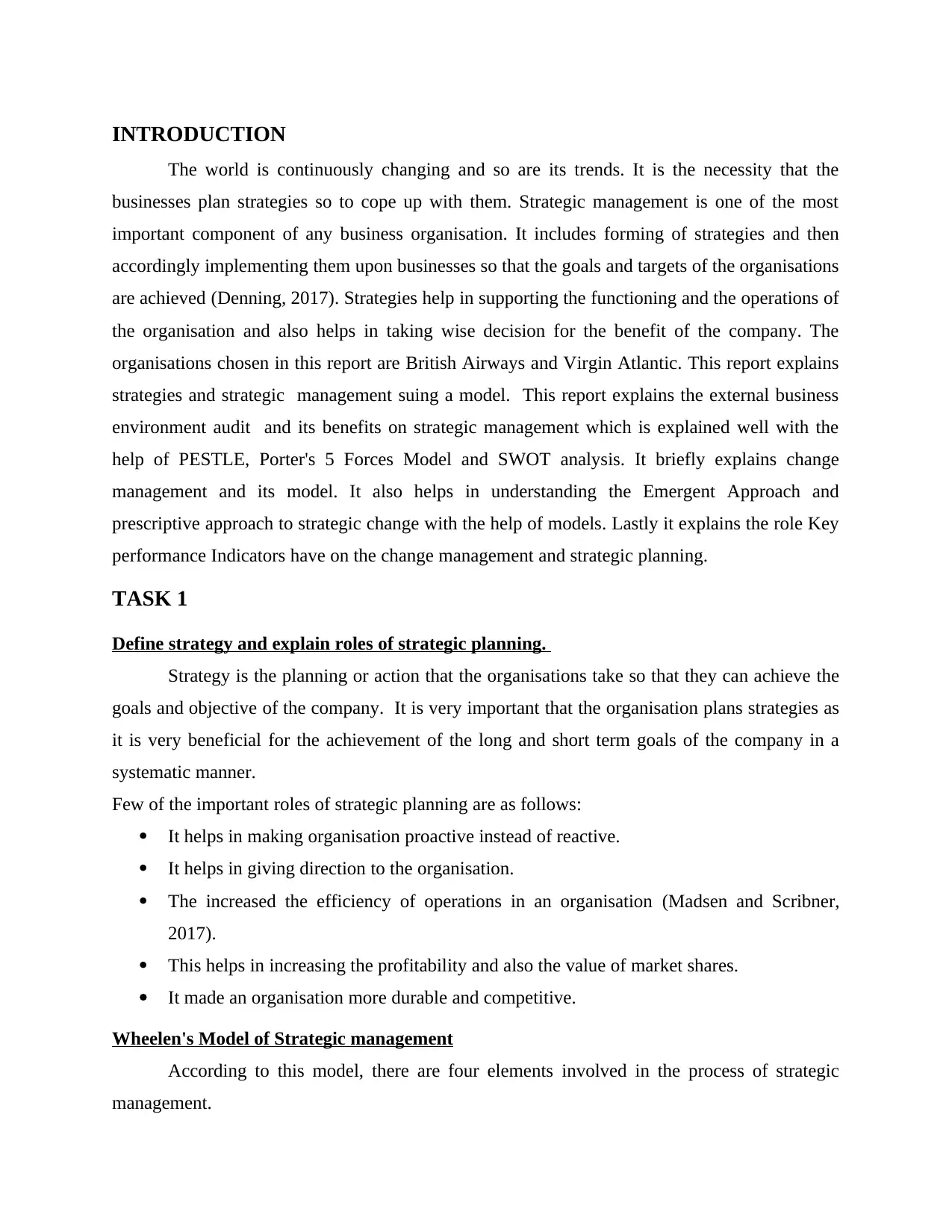
INTRODUCTION
The world is continuously changing and so are its trends. It is the necessity that the
businesses plan strategies so to cope up with them. Strategic management is one of the most
important component of any business organisation. It includes forming of strategies and then
accordingly implementing them upon businesses so that the goals and targets of the organisations
are achieved (Denning, 2017). Strategies help in supporting the functioning and the operations of
the organisation and also helps in taking wise decision for the benefit of the company. The
organisations chosen in this report are British Airways and Virgin Atlantic. This report explains
strategies and strategic management suing a model. This report explains the external business
environment audit and its benefits on strategic management which is explained well with the
help of PESTLE, Porter's 5 Forces Model and SWOT analysis. It briefly explains change
management and its model. It also helps in understanding the Emergent Approach and
prescriptive approach to strategic change with the help of models. Lastly it explains the role Key
performance Indicators have on the change management and strategic planning.
TASK 1
Define strategy and explain roles of strategic planning.
Strategy is the planning or action that the organisations take so that they can achieve the
goals and objective of the company. It is very important that the organisation plans strategies as
it is very beneficial for the achievement of the long and short term goals of the company in a
systematic manner.
Few of the important roles of strategic planning are as follows:
It helps in making organisation proactive instead of reactive.
It helps in giving direction to the organisation.
The increased the efficiency of operations in an organisation (Madsen and Scribner,
2017).
This helps in increasing the profitability and also the value of market shares.
It made an organisation more durable and competitive.
Wheelen's Model of Strategic management
According to this model, there are four elements involved in the process of strategic
management.
The world is continuously changing and so are its trends. It is the necessity that the
businesses plan strategies so to cope up with them. Strategic management is one of the most
important component of any business organisation. It includes forming of strategies and then
accordingly implementing them upon businesses so that the goals and targets of the organisations
are achieved (Denning, 2017). Strategies help in supporting the functioning and the operations of
the organisation and also helps in taking wise decision for the benefit of the company. The
organisations chosen in this report are British Airways and Virgin Atlantic. This report explains
strategies and strategic management suing a model. This report explains the external business
environment audit and its benefits on strategic management which is explained well with the
help of PESTLE, Porter's 5 Forces Model and SWOT analysis. It briefly explains change
management and its model. It also helps in understanding the Emergent Approach and
prescriptive approach to strategic change with the help of models. Lastly it explains the role Key
performance Indicators have on the change management and strategic planning.
TASK 1
Define strategy and explain roles of strategic planning.
Strategy is the planning or action that the organisations take so that they can achieve the
goals and objective of the company. It is very important that the organisation plans strategies as
it is very beneficial for the achievement of the long and short term goals of the company in a
systematic manner.
Few of the important roles of strategic planning are as follows:
It helps in making organisation proactive instead of reactive.
It helps in giving direction to the organisation.
The increased the efficiency of operations in an organisation (Madsen and Scribner,
2017).
This helps in increasing the profitability and also the value of market shares.
It made an organisation more durable and competitive.
Wheelen's Model of Strategic management
According to this model, there are four elements involved in the process of strategic
management.
⊘ This is a preview!⊘
Do you want full access?
Subscribe today to unlock all pages.

Trusted by 1+ million students worldwide
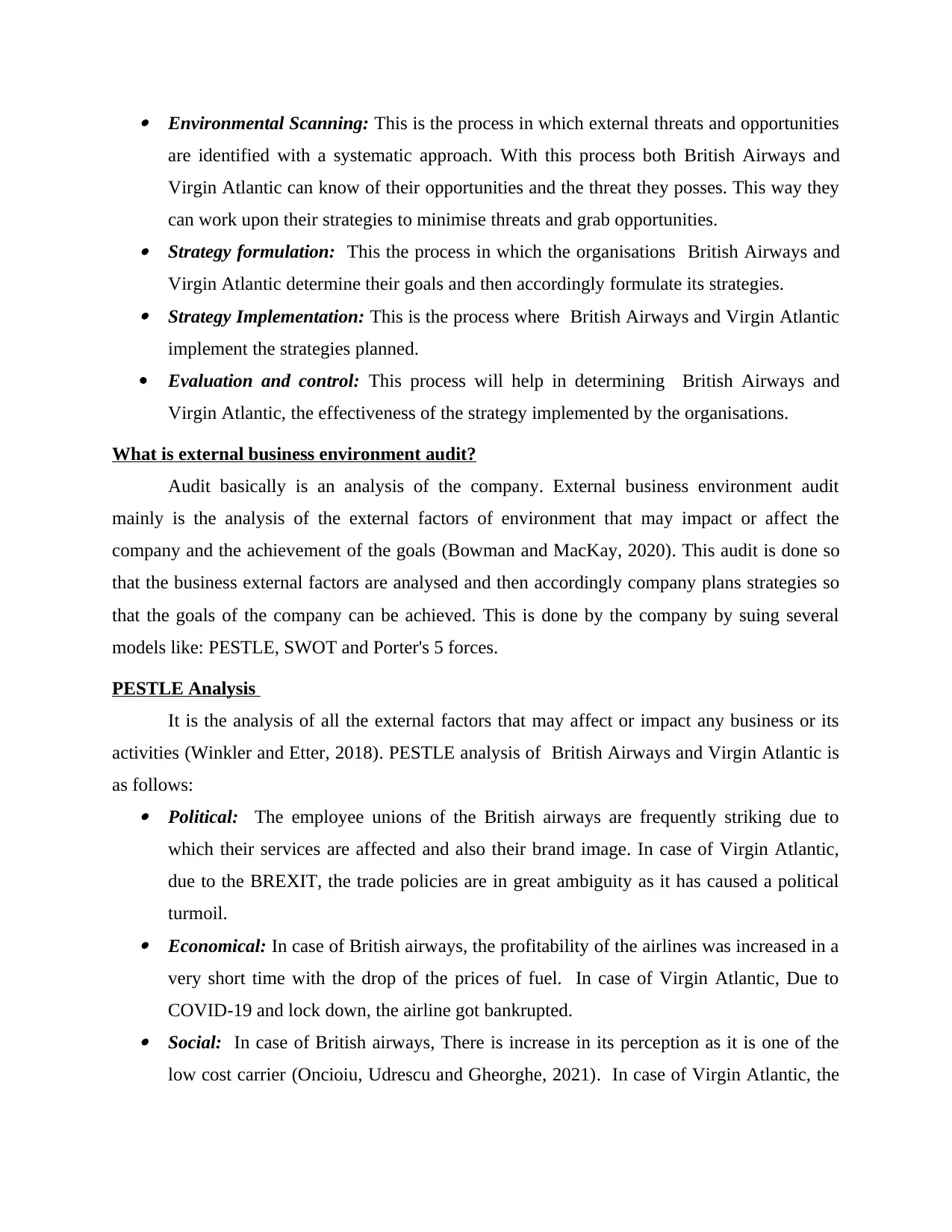
Environmental Scanning: This is the process in which external threats and opportunities
are identified with a systematic approach. With this process both British Airways and
Virgin Atlantic can know of their opportunities and the threat they posses. This way they
can work upon their strategies to minimise threats and grab opportunities. Strategy formulation: This the process in which the organisations British Airways and
Virgin Atlantic determine their goals and then accordingly formulate its strategies. Strategy Implementation: This is the process where British Airways and Virgin Atlantic
implement the strategies planned.
Evaluation and control: This process will help in determining British Airways and
Virgin Atlantic, the effectiveness of the strategy implemented by the organisations.
What is external business environment audit?
Audit basically is an analysis of the company. External business environment audit
mainly is the analysis of the external factors of environment that may impact or affect the
company and the achievement of the goals (Bowman and MacKay, 2020). This audit is done so
that the business external factors are analysed and then accordingly company plans strategies so
that the goals of the company can be achieved. This is done by the company by suing several
models like: PESTLE, SWOT and Porter's 5 forces.
PESTLE Analysis
It is the analysis of all the external factors that may affect or impact any business or its
activities (Winkler and Etter, 2018). PESTLE analysis of British Airways and Virgin Atlantic is
as follows: Political: The employee unions of the British airways are frequently striking due to
which their services are affected and also their brand image. In case of Virgin Atlantic,
due to the BREXIT, the trade policies are in great ambiguity as it has caused a political
turmoil. Economical: In case of British airways, the profitability of the airlines was increased in a
very short time with the drop of the prices of fuel. In case of Virgin Atlantic, Due to
COVID-19 and lock down, the airline got bankrupted. Social: In case of British airways, There is increase in its perception as it is one of the
low cost carrier (Oncioiu, Udrescu and Gheorghe, 2021). In case of Virgin Atlantic, the
are identified with a systematic approach. With this process both British Airways and
Virgin Atlantic can know of their opportunities and the threat they posses. This way they
can work upon their strategies to minimise threats and grab opportunities. Strategy formulation: This the process in which the organisations British Airways and
Virgin Atlantic determine their goals and then accordingly formulate its strategies. Strategy Implementation: This is the process where British Airways and Virgin Atlantic
implement the strategies planned.
Evaluation and control: This process will help in determining British Airways and
Virgin Atlantic, the effectiveness of the strategy implemented by the organisations.
What is external business environment audit?
Audit basically is an analysis of the company. External business environment audit
mainly is the analysis of the external factors of environment that may impact or affect the
company and the achievement of the goals (Bowman and MacKay, 2020). This audit is done so
that the business external factors are analysed and then accordingly company plans strategies so
that the goals of the company can be achieved. This is done by the company by suing several
models like: PESTLE, SWOT and Porter's 5 forces.
PESTLE Analysis
It is the analysis of all the external factors that may affect or impact any business or its
activities (Winkler and Etter, 2018). PESTLE analysis of British Airways and Virgin Atlantic is
as follows: Political: The employee unions of the British airways are frequently striking due to
which their services are affected and also their brand image. In case of Virgin Atlantic,
due to the BREXIT, the trade policies are in great ambiguity as it has caused a political
turmoil. Economical: In case of British airways, the profitability of the airlines was increased in a
very short time with the drop of the prices of fuel. In case of Virgin Atlantic, Due to
COVID-19 and lock down, the airline got bankrupted. Social: In case of British airways, There is increase in its perception as it is one of the
low cost carrier (Oncioiu, Udrescu and Gheorghe, 2021). In case of Virgin Atlantic, the
Paraphrase This Document
Need a fresh take? Get an instant paraphrase of this document with our AI Paraphraser
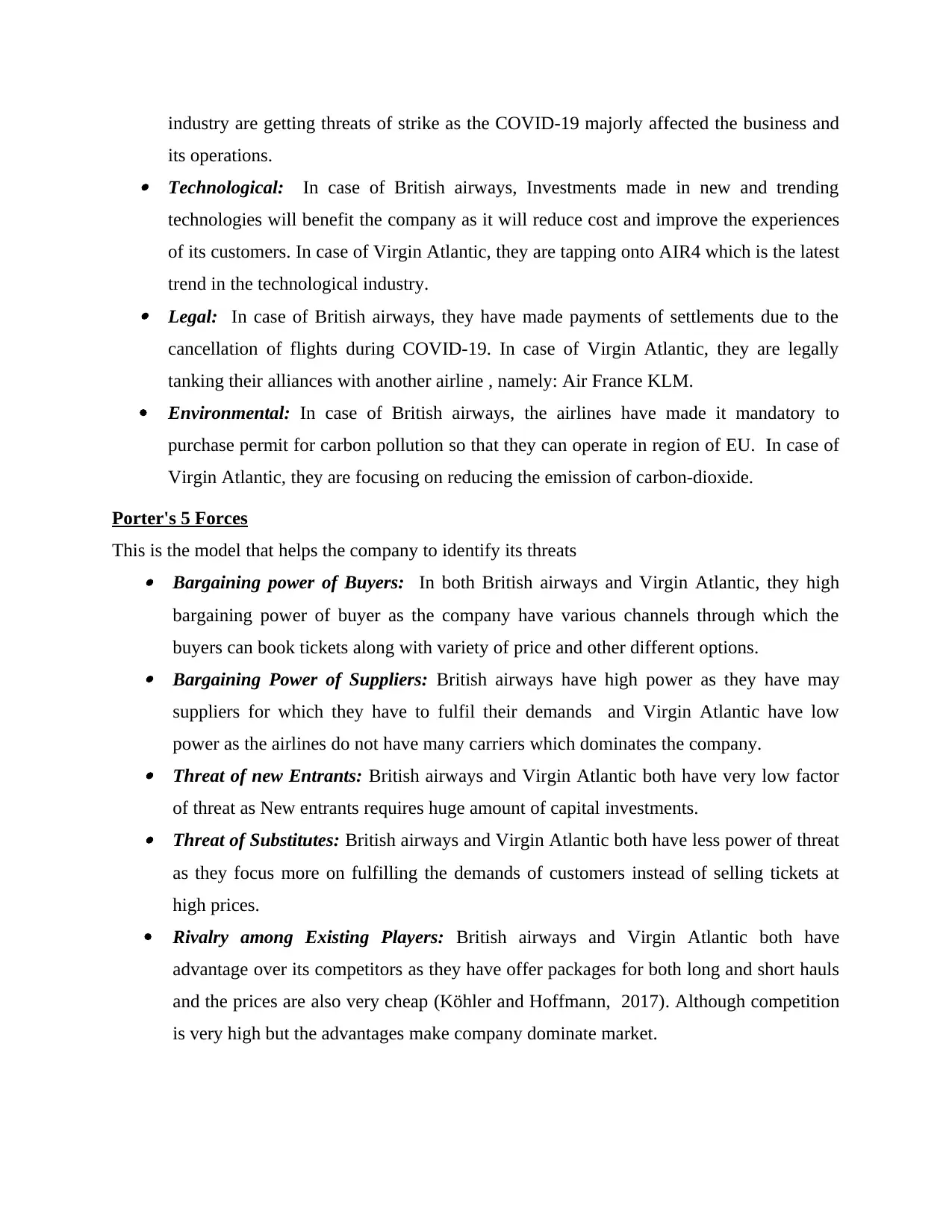
industry are getting threats of strike as the COVID-19 majorly affected the business and
its operations. Technological: In case of British airways, Investments made in new and trending
technologies will benefit the company as it will reduce cost and improve the experiences
of its customers. In case of Virgin Atlantic, they are tapping onto AIR4 which is the latest
trend in the technological industry. Legal: In case of British airways, they have made payments of settlements due to the
cancellation of flights during COVID-19. In case of Virgin Atlantic, they are legally
tanking their alliances with another airline , namely: Air France KLM.
Environmental: In case of British airways, the airlines have made it mandatory to
purchase permit for carbon pollution so that they can operate in region of EU. In case of
Virgin Atlantic, they are focusing on reducing the emission of carbon-dioxide.
Porter's 5 Forces
This is the model that helps the company to identify its threats Bargaining power of Buyers: In both British airways and Virgin Atlantic, they high
bargaining power of buyer as the company have various channels through which the
buyers can book tickets along with variety of price and other different options. Bargaining Power of Suppliers: British airways have high power as they have may
suppliers for which they have to fulfil their demands and Virgin Atlantic have low
power as the airlines do not have many carriers which dominates the company. Threat of new Entrants: British airways and Virgin Atlantic both have very low factor
of threat as New entrants requires huge amount of capital investments. Threat of Substitutes: British airways and Virgin Atlantic both have less power of threat
as they focus more on fulfilling the demands of customers instead of selling tickets at
high prices.
Rivalry among Existing Players: British airways and Virgin Atlantic both have
advantage over its competitors as they have offer packages for both long and short hauls
and the prices are also very cheap (Köhler and Hoffmann, 2017). Although competition
is very high but the advantages make company dominate market.
its operations. Technological: In case of British airways, Investments made in new and trending
technologies will benefit the company as it will reduce cost and improve the experiences
of its customers. In case of Virgin Atlantic, they are tapping onto AIR4 which is the latest
trend in the technological industry. Legal: In case of British airways, they have made payments of settlements due to the
cancellation of flights during COVID-19. In case of Virgin Atlantic, they are legally
tanking their alliances with another airline , namely: Air France KLM.
Environmental: In case of British airways, the airlines have made it mandatory to
purchase permit for carbon pollution so that they can operate in region of EU. In case of
Virgin Atlantic, they are focusing on reducing the emission of carbon-dioxide.
Porter's 5 Forces
This is the model that helps the company to identify its threats Bargaining power of Buyers: In both British airways and Virgin Atlantic, they high
bargaining power of buyer as the company have various channels through which the
buyers can book tickets along with variety of price and other different options. Bargaining Power of Suppliers: British airways have high power as they have may
suppliers for which they have to fulfil their demands and Virgin Atlantic have low
power as the airlines do not have many carriers which dominates the company. Threat of new Entrants: British airways and Virgin Atlantic both have very low factor
of threat as New entrants requires huge amount of capital investments. Threat of Substitutes: British airways and Virgin Atlantic both have less power of threat
as they focus more on fulfilling the demands of customers instead of selling tickets at
high prices.
Rivalry among Existing Players: British airways and Virgin Atlantic both have
advantage over its competitors as they have offer packages for both long and short hauls
and the prices are also very cheap (Köhler and Hoffmann, 2017). Although competition
is very high but the advantages make company dominate market.
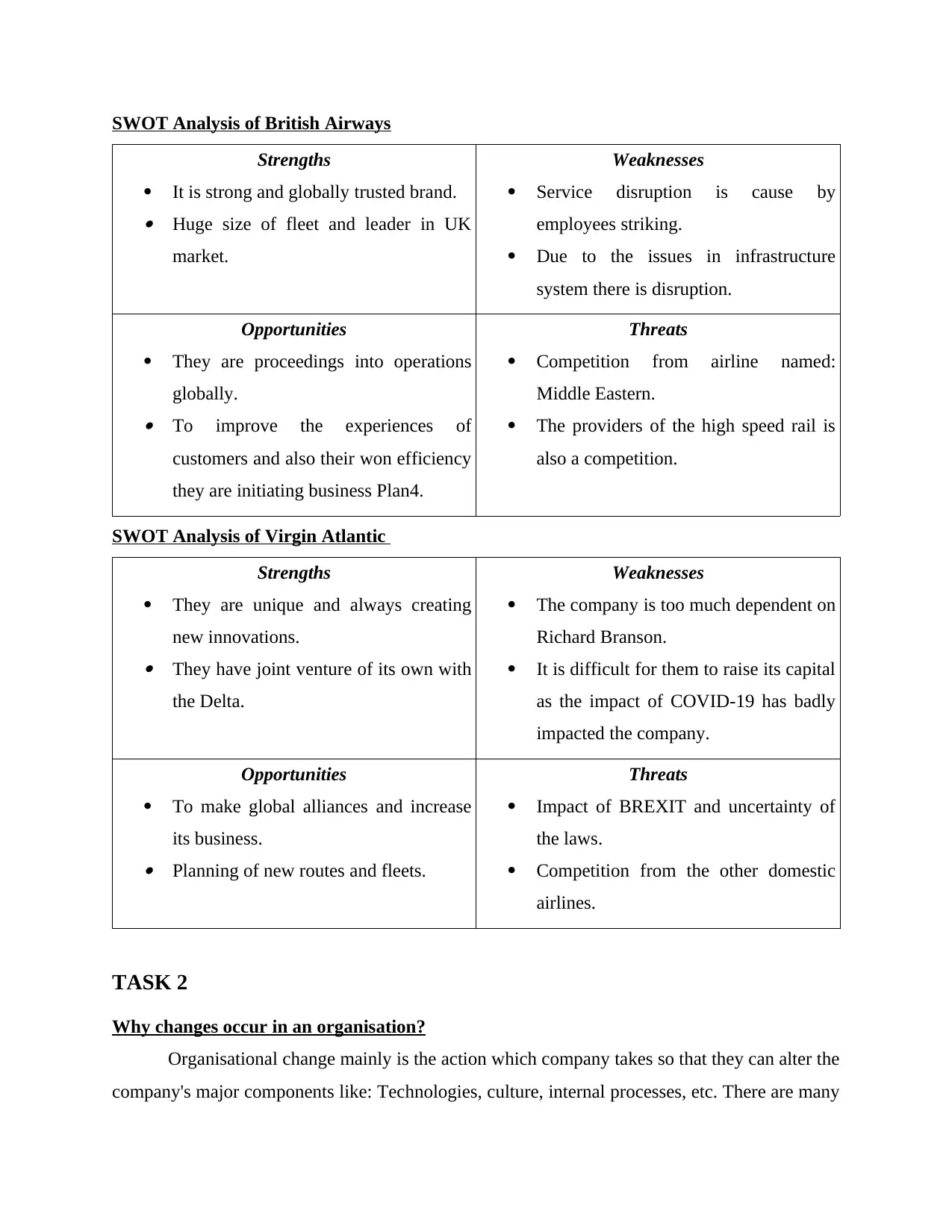
SWOT Analysis of British Airways
Strengths
It is strong and globally trusted brand. Huge size of fleet and leader in UK
market.
Weaknesses
Service disruption is cause by
employees striking.
Due to the issues in infrastructure
system there is disruption.
Opportunities
They are proceedings into operations
globally. To improve the experiences of
customers and also their won efficiency
they are initiating business Plan4.
Threats
Competition from airline named:
Middle Eastern.
The providers of the high speed rail is
also a competition.
SWOT Analysis of Virgin Atlantic
Strengths
They are unique and always creating
new innovations. They have joint venture of its own with
the Delta.
Weaknesses
The company is too much dependent on
Richard Branson.
It is difficult for them to raise its capital
as the impact of COVID-19 has badly
impacted the company.
Opportunities
To make global alliances and increase
its business. Planning of new routes and fleets.
Threats
Impact of BREXIT and uncertainty of
the laws.
Competition from the other domestic
airlines.
TASK 2
Why changes occur in an organisation?
Organisational change mainly is the action which company takes so that they can alter the
company's major components like: Technologies, culture, internal processes, etc. There are many
Strengths
It is strong and globally trusted brand. Huge size of fleet and leader in UK
market.
Weaknesses
Service disruption is cause by
employees striking.
Due to the issues in infrastructure
system there is disruption.
Opportunities
They are proceedings into operations
globally. To improve the experiences of
customers and also their won efficiency
they are initiating business Plan4.
Threats
Competition from airline named:
Middle Eastern.
The providers of the high speed rail is
also a competition.
SWOT Analysis of Virgin Atlantic
Strengths
They are unique and always creating
new innovations. They have joint venture of its own with
the Delta.
Weaknesses
The company is too much dependent on
Richard Branson.
It is difficult for them to raise its capital
as the impact of COVID-19 has badly
impacted the company.
Opportunities
To make global alliances and increase
its business. Planning of new routes and fleets.
Threats
Impact of BREXIT and uncertainty of
the laws.
Competition from the other domestic
airlines.
TASK 2
Why changes occur in an organisation?
Organisational change mainly is the action which company takes so that they can alter the
company's major components like: Technologies, culture, internal processes, etc. There are many
⊘ This is a preview!⊘
Do you want full access?
Subscribe today to unlock all pages.

Trusted by 1+ million students worldwide
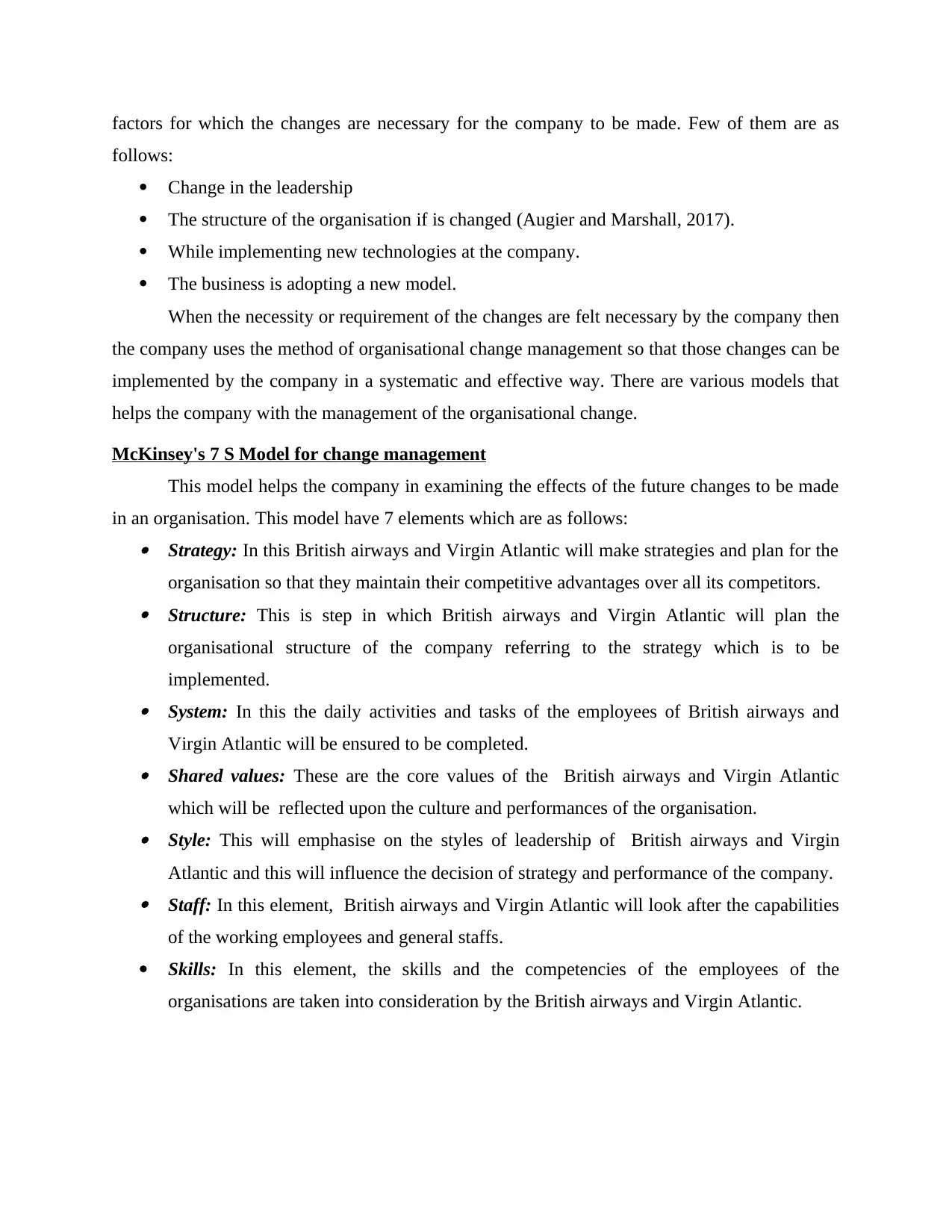
factors for which the changes are necessary for the company to be made. Few of them are as
follows:
Change in the leadership
The structure of the organisation if is changed (Augier and Marshall, 2017).
While implementing new technologies at the company.
The business is adopting a new model.
When the necessity or requirement of the changes are felt necessary by the company then
the company uses the method of organisational change management so that those changes can be
implemented by the company in a systematic and effective way. There are various models that
helps the company with the management of the organisational change.
McKinsey's 7 S Model for change management
This model helps the company in examining the effects of the future changes to be made
in an organisation. This model have 7 elements which are as follows: Strategy: In this British airways and Virgin Atlantic will make strategies and plan for the
organisation so that they maintain their competitive advantages over all its competitors. Structure: This is step in which British airways and Virgin Atlantic will plan the
organisational structure of the company referring to the strategy which is to be
implemented. System: In this the daily activities and tasks of the employees of British airways and
Virgin Atlantic will be ensured to be completed. Shared values: These are the core values of the British airways and Virgin Atlantic
which will be reflected upon the culture and performances of the organisation. Style: This will emphasise on the styles of leadership of British airways and Virgin
Atlantic and this will influence the decision of strategy and performance of the company. Staff: In this element, British airways and Virgin Atlantic will look after the capabilities
of the working employees and general staffs.
Skills: In this element, the skills and the competencies of the employees of the
organisations are taken into consideration by the British airways and Virgin Atlantic.
follows:
Change in the leadership
The structure of the organisation if is changed (Augier and Marshall, 2017).
While implementing new technologies at the company.
The business is adopting a new model.
When the necessity or requirement of the changes are felt necessary by the company then
the company uses the method of organisational change management so that those changes can be
implemented by the company in a systematic and effective way. There are various models that
helps the company with the management of the organisational change.
McKinsey's 7 S Model for change management
This model helps the company in examining the effects of the future changes to be made
in an organisation. This model have 7 elements which are as follows: Strategy: In this British airways and Virgin Atlantic will make strategies and plan for the
organisation so that they maintain their competitive advantages over all its competitors. Structure: This is step in which British airways and Virgin Atlantic will plan the
organisational structure of the company referring to the strategy which is to be
implemented. System: In this the daily activities and tasks of the employees of British airways and
Virgin Atlantic will be ensured to be completed. Shared values: These are the core values of the British airways and Virgin Atlantic
which will be reflected upon the culture and performances of the organisation. Style: This will emphasise on the styles of leadership of British airways and Virgin
Atlantic and this will influence the decision of strategy and performance of the company. Staff: In this element, British airways and Virgin Atlantic will look after the capabilities
of the working employees and general staffs.
Skills: In this element, the skills and the competencies of the employees of the
organisations are taken into consideration by the British airways and Virgin Atlantic.
Paraphrase This Document
Need a fresh take? Get an instant paraphrase of this document with our AI Paraphraser
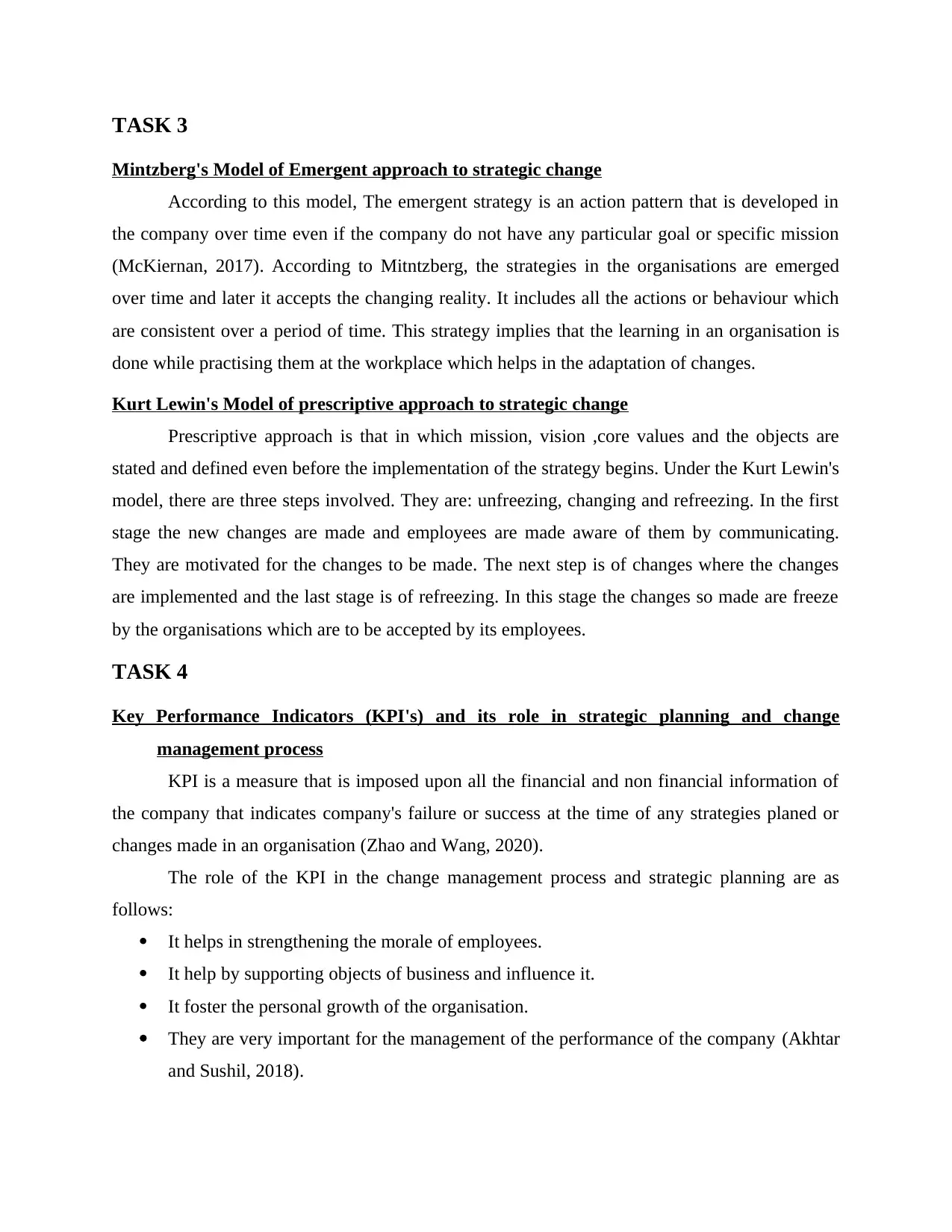
TASK 3
Mintzberg's Model of Emergent approach to strategic change
According to this model, The emergent strategy is an action pattern that is developed in
the company over time even if the company do not have any particular goal or specific mission
(McKiernan, 2017). According to Mitntzberg, the strategies in the organisations are emerged
over time and later it accepts the changing reality. It includes all the actions or behaviour which
are consistent over a period of time. This strategy implies that the learning in an organisation is
done while practising them at the workplace which helps in the adaptation of changes.
Kurt Lewin's Model of prescriptive approach to strategic change
Prescriptive approach is that in which mission, vision ,core values and the objects are
stated and defined even before the implementation of the strategy begins. Under the Kurt Lewin's
model, there are three steps involved. They are: unfreezing, changing and refreezing. In the first
stage the new changes are made and employees are made aware of them by communicating.
They are motivated for the changes to be made. The next step is of changes where the changes
are implemented and the last stage is of refreezing. In this stage the changes so made are freeze
by the organisations which are to be accepted by its employees.
TASK 4
Key Performance Indicators (KPI's) and its role in strategic planning and change
management process
KPI is a measure that is imposed upon all the financial and non financial information of
the company that indicates company's failure or success at the time of any strategies planed or
changes made in an organisation (Zhao and Wang, 2020).
The role of the KPI in the change management process and strategic planning are as
follows:
It helps in strengthening the morale of employees.
It help by supporting objects of business and influence it.
It foster the personal growth of the organisation.
They are very important for the management of the performance of the company (Akhtar
and Sushil, 2018).
Mintzberg's Model of Emergent approach to strategic change
According to this model, The emergent strategy is an action pattern that is developed in
the company over time even if the company do not have any particular goal or specific mission
(McKiernan, 2017). According to Mitntzberg, the strategies in the organisations are emerged
over time and later it accepts the changing reality. It includes all the actions or behaviour which
are consistent over a period of time. This strategy implies that the learning in an organisation is
done while practising them at the workplace which helps in the adaptation of changes.
Kurt Lewin's Model of prescriptive approach to strategic change
Prescriptive approach is that in which mission, vision ,core values and the objects are
stated and defined even before the implementation of the strategy begins. Under the Kurt Lewin's
model, there are three steps involved. They are: unfreezing, changing and refreezing. In the first
stage the new changes are made and employees are made aware of them by communicating.
They are motivated for the changes to be made. The next step is of changes where the changes
are implemented and the last stage is of refreezing. In this stage the changes so made are freeze
by the organisations which are to be accepted by its employees.
TASK 4
Key Performance Indicators (KPI's) and its role in strategic planning and change
management process
KPI is a measure that is imposed upon all the financial and non financial information of
the company that indicates company's failure or success at the time of any strategies planed or
changes made in an organisation (Zhao and Wang, 2020).
The role of the KPI in the change management process and strategic planning are as
follows:
It helps in strengthening the morale of employees.
It help by supporting objects of business and influence it.
It foster the personal growth of the organisation.
They are very important for the management of the performance of the company (Akhtar
and Sushil, 2018).
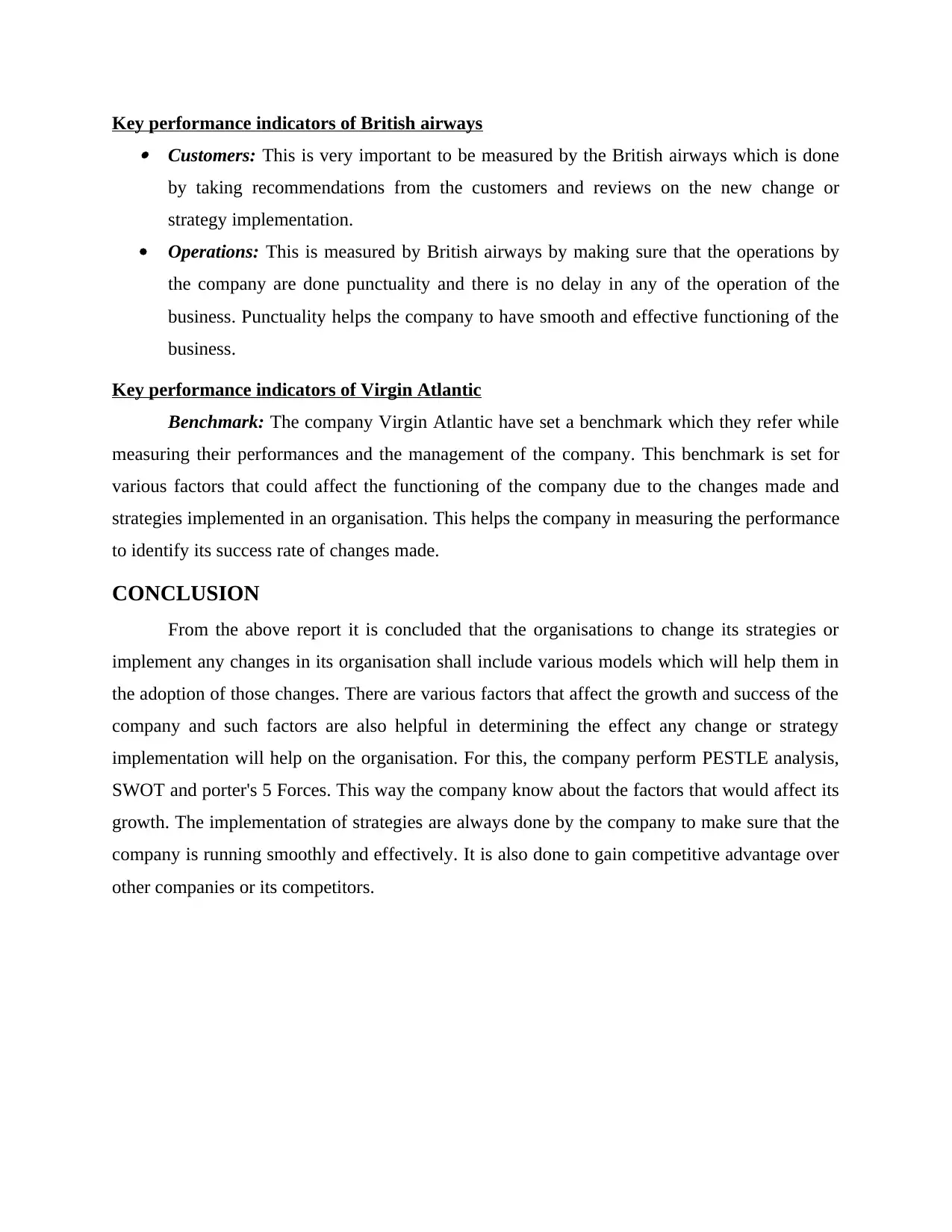
Key performance indicators of British airways Customers: This is very important to be measured by the British airways which is done
by taking recommendations from the customers and reviews on the new change or
strategy implementation.
Operations: This is measured by British airways by making sure that the operations by
the company are done punctuality and there is no delay in any of the operation of the
business. Punctuality helps the company to have smooth and effective functioning of the
business.
Key performance indicators of Virgin Atlantic
Benchmark: The company Virgin Atlantic have set a benchmark which they refer while
measuring their performances and the management of the company. This benchmark is set for
various factors that could affect the functioning of the company due to the changes made and
strategies implemented in an organisation. This helps the company in measuring the performance
to identify its success rate of changes made.
CONCLUSION
From the above report it is concluded that the organisations to change its strategies or
implement any changes in its organisation shall include various models which will help them in
the adoption of those changes. There are various factors that affect the growth and success of the
company and such factors are also helpful in determining the effect any change or strategy
implementation will help on the organisation. For this, the company perform PESTLE analysis,
SWOT and porter's 5 Forces. This way the company know about the factors that would affect its
growth. The implementation of strategies are always done by the company to make sure that the
company is running smoothly and effectively. It is also done to gain competitive advantage over
other companies or its competitors.
by taking recommendations from the customers and reviews on the new change or
strategy implementation.
Operations: This is measured by British airways by making sure that the operations by
the company are done punctuality and there is no delay in any of the operation of the
business. Punctuality helps the company to have smooth and effective functioning of the
business.
Key performance indicators of Virgin Atlantic
Benchmark: The company Virgin Atlantic have set a benchmark which they refer while
measuring their performances and the management of the company. This benchmark is set for
various factors that could affect the functioning of the company due to the changes made and
strategies implemented in an organisation. This helps the company in measuring the performance
to identify its success rate of changes made.
CONCLUSION
From the above report it is concluded that the organisations to change its strategies or
implement any changes in its organisation shall include various models which will help them in
the adoption of those changes. There are various factors that affect the growth and success of the
company and such factors are also helpful in determining the effect any change or strategy
implementation will help on the organisation. For this, the company perform PESTLE analysis,
SWOT and porter's 5 Forces. This way the company know about the factors that would affect its
growth. The implementation of strategies are always done by the company to make sure that the
company is running smoothly and effectively. It is also done to gain competitive advantage over
other companies or its competitors.
⊘ This is a preview!⊘
Do you want full access?
Subscribe today to unlock all pages.

Trusted by 1+ million students worldwide
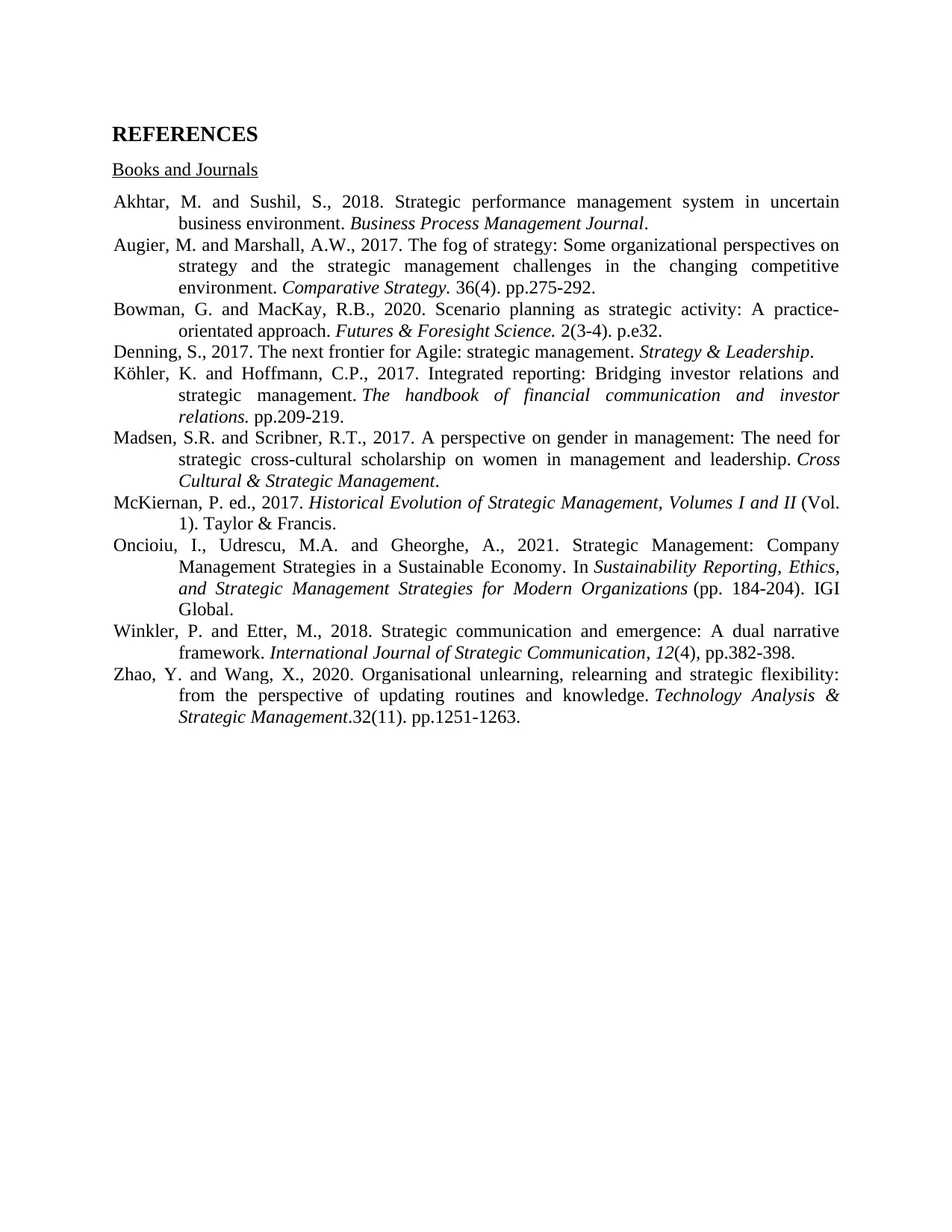
REFERENCES
Books and Journals
Akhtar, M. and Sushil, S., 2018. Strategic performance management system in uncertain
business environment. Business Process Management Journal.
Augier, M. and Marshall, A.W., 2017. The fog of strategy: Some organizational perspectives on
strategy and the strategic management challenges in the changing competitive
environment. Comparative Strategy. 36(4). pp.275-292.
Bowman, G. and MacKay, R.B., 2020. Scenario planning as strategic activity: A practice‐
orientated approach. Futures & Foresight Science. 2(3-4). p.e32.
Denning, S., 2017. The next frontier for Agile: strategic management. Strategy & Leadership.
Köhler, K. and Hoffmann, C.P., 2017. Integrated reporting: Bridging investor relations and
strategic management. The handbook of financial communication and investor
relations. pp.209-219.
Madsen, S.R. and Scribner, R.T., 2017. A perspective on gender in management: The need for
strategic cross-cultural scholarship on women in management and leadership. Cross
Cultural & Strategic Management.
McKiernan, P. ed., 2017. Historical Evolution of Strategic Management, Volumes I and II (Vol.
1). Taylor & Francis.
Oncioiu, I., Udrescu, M.A. and Gheorghe, A., 2021. Strategic Management: Company
Management Strategies in a Sustainable Economy. In Sustainability Reporting, Ethics,
and Strategic Management Strategies for Modern Organizations (pp. 184-204). IGI
Global.
Winkler, P. and Etter, M., 2018. Strategic communication and emergence: A dual narrative
framework. International Journal of Strategic Communication, 12(4), pp.382-398.
Zhao, Y. and Wang, X., 2020. Organisational unlearning, relearning and strategic flexibility:
from the perspective of updating routines and knowledge. Technology Analysis &
Strategic Management.32(11). pp.1251-1263.
Books and Journals
Akhtar, M. and Sushil, S., 2018. Strategic performance management system in uncertain
business environment. Business Process Management Journal.
Augier, M. and Marshall, A.W., 2017. The fog of strategy: Some organizational perspectives on
strategy and the strategic management challenges in the changing competitive
environment. Comparative Strategy. 36(4). pp.275-292.
Bowman, G. and MacKay, R.B., 2020. Scenario planning as strategic activity: A practice‐
orientated approach. Futures & Foresight Science. 2(3-4). p.e32.
Denning, S., 2017. The next frontier for Agile: strategic management. Strategy & Leadership.
Köhler, K. and Hoffmann, C.P., 2017. Integrated reporting: Bridging investor relations and
strategic management. The handbook of financial communication and investor
relations. pp.209-219.
Madsen, S.R. and Scribner, R.T., 2017. A perspective on gender in management: The need for
strategic cross-cultural scholarship on women in management and leadership. Cross
Cultural & Strategic Management.
McKiernan, P. ed., 2017. Historical Evolution of Strategic Management, Volumes I and II (Vol.
1). Taylor & Francis.
Oncioiu, I., Udrescu, M.A. and Gheorghe, A., 2021. Strategic Management: Company
Management Strategies in a Sustainable Economy. In Sustainability Reporting, Ethics,
and Strategic Management Strategies for Modern Organizations (pp. 184-204). IGI
Global.
Winkler, P. and Etter, M., 2018. Strategic communication and emergence: A dual narrative
framework. International Journal of Strategic Communication, 12(4), pp.382-398.
Zhao, Y. and Wang, X., 2020. Organisational unlearning, relearning and strategic flexibility:
from the perspective of updating routines and knowledge. Technology Analysis &
Strategic Management.32(11). pp.1251-1263.
1 out of 10
Related Documents
Your All-in-One AI-Powered Toolkit for Academic Success.
+13062052269
info@desklib.com
Available 24*7 on WhatsApp / Email
![[object Object]](/_next/static/media/star-bottom.7253800d.svg)
Unlock your academic potential
Copyright © 2020–2025 A2Z Services. All Rights Reserved. Developed and managed by ZUCOL.




